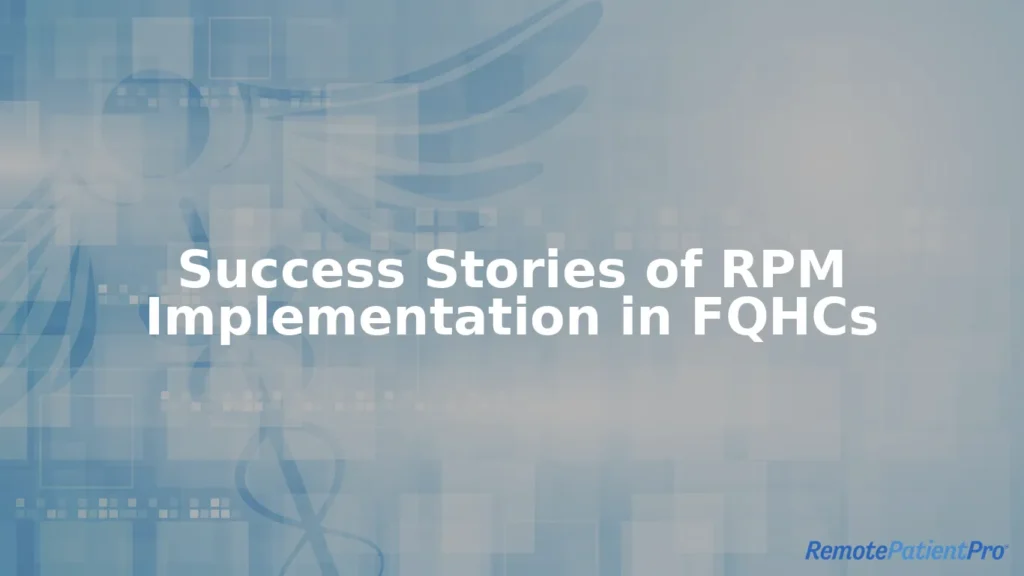Success Stories of RPM Implementation in FQHCs
Federally Qualified Health Centers (FQHCs) play a crucial role in delivering accessible, high-quality care to underserved populations, especially at a time when chronic diseases are still the leading cause of death in the U.S. However, managing those conditions effectively, reducing hospital readmissions, and improving patient engagement can be challenging for centers that don’t have access to the appropriate tools. By adopting remote patient monitoring (RPM), many centers have successfully enhanced care coordination, improved patient adherence, and reduced healthcare costs. These success stories of RPM implementation in FQHCs highlight the transformative impact of digital health solutions in community healthcare settings.
Case Study #1
Reducing Hospital Readmissions in a Rural FQHC
Challenge:
A rural FQHC serving patients with diabetes and heart disease struggled with high 30-day hospital readmission rates, leading to increased healthcare costs and resource strain.
Solution:
The health center implemented an RPM platform to remotely monitor blood glucose, blood pressure, and oxygen levels. Patients used user-friendly RPM devices that automatically transmitted health data to care teams.
Results:
- One-third reduction in hospital readmissions within six months.
- Improved medication adherence due to real-time provider interventions.
- Increased patient engagement, with over three-quarters of enrolled patients regularly using RPM tools.
Case Study #2
Improving Hypertension Management in an Urban FQHC
Challenge:
An urban FQHC with a predominantly low-income patient population faced difficulties in managing hypertension due to limited follow-up care and poor patient compliance.
Solution:
The FQHC integrated RPM with its telehealth visits, allowing clinicians to track blood pressure trends remotely and adjust treatment plans in real time.
Results:
- Almost half of hypertensive patients achieved controlled blood pressure levels within four months.
- Emergency visits for hypertension-related complications dropped by a quarter.
- Care coordination between physicians and nurses improved, leading to more proactive interventions.
Case Study #3
Enhancing Diabetes Management With RPM and Patient Education
Challenge:
A community health center saw rising rates of uncontrolled diabetes due to inconsistent glucose monitoring and low patient engagement.
Solution:
By implementing RPM with personalized coaching, the FQHC empowered patients to track their blood sugar levels with automated alerts and direct provider communication through a mobile app.
Results:
- HbA1c levels dropped by an average of 1.5% within six months.
- Patient participation in diabetes education programs increased by 50%.
- RPM adoption led to fewer complications and ER visits for diabetic patients.
Why RPM Is a Powerful Solution for FQHCs
These examples show that RPM is a scalable, cost-effective solution that helps FQHCs:
- Reduce hospital readmissions through real-time monitoring.
- Improve chronic disease management with continuous patient data tracking.
- Enhance patient engagement and adherence to care plans.
- Optimize resource use and alleviate staff workload.
How Our RPM Platform Supports FQHCs
RemotePatientPro™’s RPM platform is designed to support FQHCs by offering:
- Easy-to-use, automated monitoring devices for chronic conditions.
- Custom alerts for early intervention and provider follow-ups.
- Seamless integration with EHR systems for streamlined care coordination.
- Cost-effective solutions tailored for community health settings.
Implement RPM in Your FQHC Today
With the right technology, training, and patient engagement, FQHCs can achieve better health outcomes while optimizing resources.
Ready to implement RPM at your center? Schedule a demo today and see how we can benefit your community!



